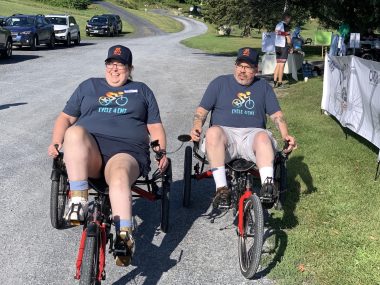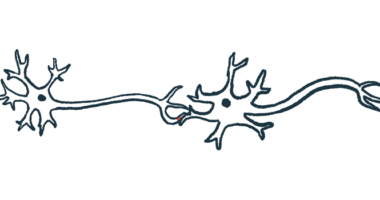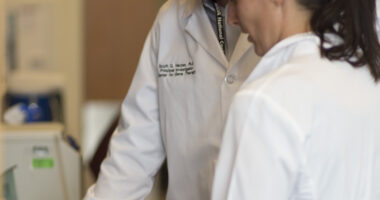One Man’s Mission: Translate the Science of CMT Disease for Others
Since 2002, Kenneth Raymond has worked to help people understand CMT

Kenneth Raymond, who was diagnosed with Charcot-Marie-Tooth disease 20 years ago, started the website Experts in CMT in 2020. (Courtesy of Kenneth Raymond)
When Kenneth Raymond was diagnosed with Charcot-Marie-Tooth (CMT) disease subtype 1A more than 20 years ago, there was little information about the disease that a layman could read and understand.
So he set out to remedy that.
In 2020, Raymond launched a website called the Cryptid Sloth (now known as Experts in CMT) to explain the science and biology of CMT to people who weren’t doctors or researchers. He also created the first publicly available database of genes linked to CMT and their related subtypes. That became his first reference book, “CMT-Associated Genes and Their Related Subtypes,” which was released last August as a PDF on the CMT Association’s (CMTA) website. It’s free for anyone to read and has been downloaded more than 4,200 times since late last year.
Raymond, 49, recently self-published the reference book, “Charcot-Marie-Tooth Disease Gene and Subtype Discovery: The Complete Bibliography,” which catalogs every discovered subtype of CMT as of fall 2022. The book, which has sold just over 300 copies, is available as an e-book or a paperback on Amazon.

Kenneth Raymond, right, rides with fellow CMTA Advisory Board member Kate Lair at the 2022 Cycle 4 CMT in Charlotte, Vermont, in August 2022. (Photo by Bob Derosa)
“There was a big vacuum and void of just some of the most basic CMT information for patients,” Raymond said in an interview with Charcot-Marie-Tooth News. “I recognized that I’m not the only one with this disease. We can’t get information. How can I fix this? So I just dove in headfirst with libraries and limited internet availability for information on the disease.”
Raymond, who lives outside Detroit, was diagnosed with CMT at age 29 in 2002 after a life of unexplained falls, surgeries, pain, fatigue, and muscle weakness. He’d been misdiagnosed with Friedreich’s ataxia and muscular dystrophy, and was accused of making his problems up to get attention.
Inspired to learn more about CMT and advocate for others
Early on, Raymond made it a point to see well-known CMT expert Michael Shy, MD, director of the Charcot-Marie-Tooth Clinic and co-director of the Neuromuscular Program at Wayne State University in Detroit.
Shy and his team inspired Raymond to learn more about the condition and become an advocate for others.
“I somehow figured out how to take all of that stuff and translate it into something that nonmedical CMTers could relate to,” Raymond said.
He worked at a high-speed metal stamping plant when he was diagnosed, but realized after a few years that he needed to rethink his future. He left the job in 2008.
There was a big vacuum and void of just some of the most basic CMT information for patients. I recognized that I’m not the only one with this disease.
“I was at the point where I had to make a decision to either keep driving myself into a grave by doing that stuff or leave the workforce and figure out something else,” said Raymond, who has five children and two grandchildren.
The move gave him a chance to become more active on CMT social media sites and learn the ins and outs of the condition.
In the summer of 2020, he became a moderator for the CMTA Facebook page and started fielding questions from patients about their genetic test results.

Kenneth Raymond was diagnosed with CMT1A in 2002 when he was 29. (Courtesy of Kenneth Raymond)
To support his answers to patient questions, he spent a lot of time reviewing existing and new scientific literature that showed new CMT-related gene discoveries and subtypes, developing a spreadsheet of everything he found that he eventually turned into a searchable database on his website.
“Rather than just continually retyping the same stuff over and over in comments and answering questions and whatnot, I wanted to create a space that becomes a repository of information where I could just grab a link and then share on social media when needed,” Raymond said. “And that’s kind of how the original website and the Cryptid Sloth and Cryptid Sloth blog was started.”
On his website, Raymond notes that scientists have so far discovered 124 genes with CMT-causing mutations that account for 158 subtypes of the disease.
“It just grew to become such an extensive database of information that I didn’t feel was right for me to hold on to it, and hold it all myself,” he said.
He even meets one on one with patients to discuss their genetic results, analyzing test results for free — although he does accept donations.
Raymond also serves as a member of the CMTA Advisory Board. Last summer, Raymond spoke alongside Ashraf Elsayegh, MD, a pulmonary specialist in CMT at Cedars-Sinai Medical Center, about CMT-related breathing issues.
More discussion about breathing issues in CMT
Raymond said he wants to see more awareness about breathing problems with CMT. He’s dealt with the effects of neuromuscular respiratory failure caused by the disease.
“As a patient, of everything I deal with and CMT, the breathing is what I hate the most. I’ll gladly take anything else. It takes your life away and it completely changes your life,” said Raymond, who uses an average volume-assured pressure support machine to help him breathe whenever he rests or sleeps. He said he wonders if he’d be alive today without the device.
Raymond sees more discussion about breathing issues on social media by CMT patients, but believes there are still doctors who don’t think breathing is a problem for people with the disease.
That’s partly why Experts in CMT published “Respiratory Involvement in Charcot-Marie-Tooth Disease: A Brief Overview” in December. The document outlines how CMT causes breathing problems and related symptoms, and how it might be diagnosed. He’s also writing another reference book on breathing.
Raymond credits his natural curiosity for his becoming an expert and resource to people with CMT in such a relatively short time.
“I never stopped learning. I can never know enough,” Raymond said. “I’m constantly trying to improve how I discuss everything associated with CMT and the various topics related to CMT.”







